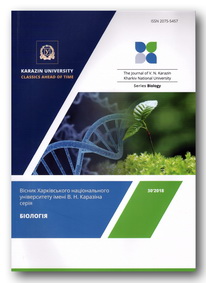Change in the karyotype of the embryo as a cause of spontaneous abortion in the first trimester
Abstract
Currently, one of the most actual health problems in the world is the problem of a spontaneous abortion. Chromosomal abnormalities are one of the main reasons of early abortion, stillbirth or the birth of a child with multiple congenital malformations. The results of karyotyping of chorionic villi from 149 patients with diagnoses of "undeveloped pregnancy" or "anembryonia" were presented in the article. Metaphase chromosomes were used for cytogenetic research of the embryos. The samples were obtained from cytotrophoblast cells of chorionic villi by the "direct" method, without culture, according to standard technique. A GTG-method was used for staining the chromosome slides. The cytogenetic study of chorionic villi makes it possible to identify the karyotype abnormalities, which caused the fading of pregnancy, since the chorion karyotype corresponds to the embryo karyotype The slide analysis was carried out in accordance with the international system of the human cytogenetic nomenclature. As a result of the cytogenetic study, changes in the karyotype were revealed in 53.39 % of the samples, namely, genomic mutations – aneuploidy and polyploidy. Among the aneuploidies, we found the embryos with trisomy in the autosomes 5, 13, 16, 18, 20, 21, and 22. In addition, the karyotypes with trisomy and monosomy of the X chromosome, as well as the male karyotypes with an additional copy of the X or Y chromosome were present The polyploids in the study group were represented by triploid and tetraploid karyotypes of embryos. All the above mentioned karyotype disorders were found in both full and mosaic forms. Further, some non-developing embryos contained a chimeric karyotype - "chi46,XX/46,XY". In the study group, the prevailing were the embryos with a tetraploid karyotype in a mosaic form (6.71 %), Klinefelter syndrome in a mosaic form (6.04 %), and a triploid karyotype in a mosaic form (6.04 %). A statistically significant increase in the incidence of stillbirths with mosaic tetraploid karyotype was found in 2020. The share of this pathology was 25. %. Currently, there is no reliable information on the effect of the SARS-CoV-2 virus on the embryonic genome. Nevertheless, it is known that members of the coronavirus family are responsible for serious complications during pregnancy - pregnancy fading, fetal growth retardation, premature birth, death of the mother or fetal death in the neonatal period. In this connection, we can hypothesize that mitotic disorders and, as a consequence, appearance of embryos with a tetraploid karyotype seem to be associated with a mild SARS-CoV-2 infection that occurs in pregnant women in an inconspicuous form.
Downloads
References
Atramentova L.A., Utevskaya O.M. (2008). Statistical methods in biology. Gorlovka: Likhtar. 248 p. (In Russian)
Avramenko N.V., Barkovsky D.Ye., Semenenko I.V., Kalabuchova N.A. (2015). Direct cytogenetic study of chorionic samples of the arrested pregnancy tissues according to the Regional Reproductive Center materials. Current Issues in Pharmacy and Medicine: Science and Practice, 3(19), 52–56. (In Russian) https://doi.org/10.14739/2409-2932.2015.3.52645
Bashmakova N.V., Tretyakova T.B., Demchenko N.S. (2013). Cytogenetic disorders in embryos during non-developing pregnancy. Russian Bulletin of Obstetrician-Gynecologist, 13(4), 18–21. (In Russian)
Chiryaeva O.G., Pendina A.A., Tikhonov A.V. et al. (2012). A comparative cytogenetic analysis of miscarriages following natural conception and assisted reproductive technologies. Journal of Obstetrics and Women’s Diseases, LVI(3), 132–140. (In Russian) https://doi.org/10.17816/JOWD613132-140
Favre G., Pomar L., Musso D., Baud D. (2020). 2019-nCoV epidemic: what about pregnancies? Lancet (London, England), 395(10224), e40. https://doi.org/10.1016/S0140-6736(20)30311-1
Feskov O., Zhylkova Ye., Rudenko V. et al. (2019). Features of the state of the chromosomal apparatus of the spouses with disorders of reproductive function. The Journal of V. N. Karazin Kharkiv National University. Series «Biology», 33, 41–47. (In Ukrainian) https://doi.org/10.26565/2075-5457-2019-33-6
Gontar J., Ilyin I., Parnitskaya O. (2014). The role of the cytogenetic examination of couples and abortive material in case of missed abortion. Bulletin of Problems in Biology and Medicine, 3, 1 (110), 73–77. (In Russian)
Morales C., Sánchez A., Bruguera J. et al. (2007). Cytogenetic study of spontaneous abortions using semi-direct analysis of chorionic villi samples detects the broadest spectrum of chromosome abnormalities. Am. J. Med. Genet. Part A, 146A, 66–70. https://doi.org/10.1002/ajmg.a.32058
Nikitina T.V., Sazhenova E.A., Tolmacheva E.N. et al. (2016). Comparative cytogenetic analysis of spontaneous abortions in recurrent and sporadic pregnancy losses. Biomed. Hub, 1, 1–11. https://doi.org/10.1159/000446099
Niroumanesh S., Mehdipour P., Farajpour A., Darvish S. (2011). A cytogenetic study of couples with repeated spontaneous abortions. Annals of Saudi Medicine, 31(1), 77–79. https://doi.org/10.4103/0256-4947.75785
Shaffer K.G., Slovak M.L., Campbell L.J. (2009). ISCN. An international system for human cytogenetic nomenclature. Basel: S. Karger. 138 р.
Tavokina L.V., Brovko A.A., Sopko Ya.A., Baronova E.V. (2013). Karyotyping results of the material of spontaneous abortions and miscarriages after using assisted reproductive technologies. Cytol. Genet., 47(1), 58–61. (In Russian) https://doi.org/10.3103/S009545271301009X
Veropotvelyan M.P, Shapovalenko L.G., Savarovska O.S. (2017). Incidence and spectrum of chromosomal abnormalities detected in married couples with early losses of pregnancy. Reproductive Endocrinology. Scientific and Practical Medical Journal, 3(35), 54–60. (In Ukrainian) https://doi.org/10.18370/2309-4117.2017.35.54-60
Volkov A.N., Nacheva L.V. (2020). Hypertriploidy as a cause of early embryonic arrest. Fundamental and Clinical Medicine, 5(1), 99–102. (In Russian) https://doi.org/10.23946/2500-0764-2020-5-1-99-102
Wang B.T., Chong T.P., Boyar F.Z. et al. (2014). Abnormalities in spontaneous abortions detected by G-banding and chromosomal microarray analysis (CMA) at a national reference laboratory. Molecular Cytogenetics, 7, 33. https://doi.org/10.1186/1755-8166-7-33
Wang C.L., Liu Y.Y., Wu C.H. et al. (2021). Impact of COVID-19 on Pregnancy. International Journal of Medical Sciences, 18(3), 763–767. https://doi.org/10.7150/ijms.49923
Yatsenko S.A., Quesada-Candela C., Saller D.N. et al. (2021). Cytogenetic signatures of recurrent pregnancy losses. Prenatal Diagnosis, 41, 70–78. https://doi.org/10.1002/pd.5838
Authors retain copyright of their work and grant the journal the right of its first publication under the terms of the Creative Commons Attribution License 4.0 International (CC BY 4.0), that allows others to share the work with an acknowledgement of the work's authorship.




